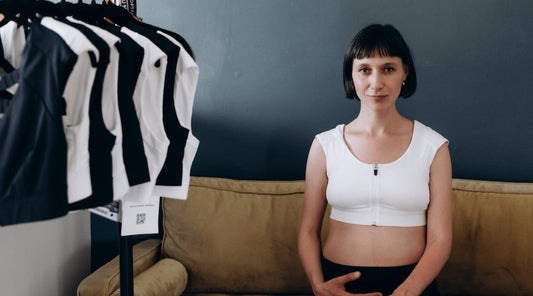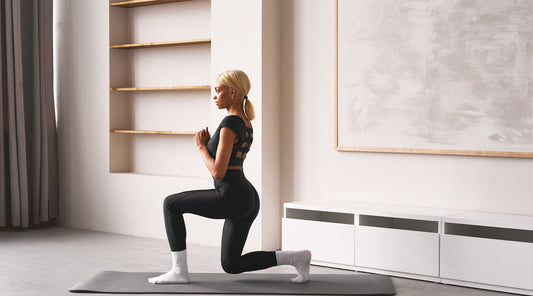Good posture involves using the least amount of energy and putting the least amount of stress on your body. In general, the more you slouch, the more your cells are working overtime to correct any imbalances. After a while, your body will start sending you more overt warnings — often in the form of neck, shoulder, and back pain.
Once you’re at this stage, you might start thinking more about your posture and how you sit, stand, walk, and sleep. Poor posture is a habit — it’s often something you don’t notice until you’re feeling the consequences. But, fortunately, just about any habit can be broken as long as you are patient and consistent. How long does it take to correct bad posture? Below, we’ll discuss bad posture habits, how to reverse them, and how to get a good posture fast.
What Is Bad Posture?
How you position your body — including your head, shoulders, and hips — relates to your posture. The spine is at the center of it all. Once it’s out of its neutral alignment, bad posture seeps in. Here are some clear physical signs of bad posture:
- Forward head posture. When you position the head in front of the shoulders instead of directly over them.
- Rounded shoulders. When your shoulders are hunched forward and your upper back is curved, causing a hunchback.
- Anterior pelvic tilt. When your pelvis pushes forward, causing an inward curve in your lower back. This is often due to prolonged sitting and weak hip flexors.
Muscle imbalances can both cause and be the result of poor posture. For example, you may slouch due to a weak core. At the same time, that slouching will put excessive strain on the neck, shoulders, and upper back muscles.
How long it takes to fix bad posture depends on how committed you are to strengthening and stretching these muscles and being mindful of your posture throughout the day. Good posture is as much of a habit as a poor one.
Effects of Prolonged Bad Posture
Prolonged bad posture is an all too common phenomenon. One study found that over 70% of people working from home complained of musculoskeletal discomfort, particularly in the neck, shoulders, and lower back (1). Our modern lives aren’t particularly conducive to good posture, whether you’re working a desk job, spending long hours on your feet, or sleeping on a mushy mattress.
Prolonged bad posture can have the following effects:
- Back and neck pain
- Recurring headaches
- Muscle fatigue
- Heartburn and other digestive issues
- Reduced focus and productivity
- Decreased lung capacity
- Protruding belly
If you’re experiencing any of these symptoms, there is good news. Most of us can undo the damage of poor posture with some rather simple lifestyle changes.
Timeframe for Posture Correction
How long does it take to fix bad posture? Remember that bad posture is habitual — and all habits can be broken. Once you’ve committed to changing that habit, you will start to see gradual improvements, sometimes as soon as a week or two.

That said, posture correction is an ongoing practice. It’s not something that can be fixed and then ignored. The goal is to develop new habits that make good posture feel natural.
Is it too late to correct your posture?
No! It’s never too late to improve your posture. Correcting bad posture is possible for just about anyone, at any age, as long as you are able to do light exercises and gentle stretches, practice posture awareness on a daily basis, and add a posture corrector to your posture-improving arsenal.
What is the fastest way to correct posture?
Poor posture — and its many uncomfortable symptoms — can take a long time to develop. Bringing your body back to its optimal alignment is certainly not a quick fix itself. But you can speed up your progress by building proper muscle memory through the techniques, tools, and exercises we lay out below.
Posture Correction Timeline: Realistic Expectations
Correcting poor posture is a journey that requires time, patience, and consistency. While it’s natural to want quick results, posture correction is about forming sustainable habits that promote better alignment and muscle memory.
In the first one to two weeks, you may notice small changes, like feeling less tension in your shoulders or being more mindful of your posture throughout the day. By three weeks, new habits start to take root, and you may find yourself naturally sitting and standing straighter. By three months, these habits stabilize, and good posture feels more natural. For some, this timeline may vary depending on factors like the severity of posture issues, commitment to exercises, and the use of supportive tools like a posture corrector.
Remember, the goal isn’t perfection overnight—it’s gradual, lasting improvement that transforms how your body feels and moves over time.
Factors Affecting Posture Correction
Posture correction involves much more than just remembering to sit and stand up straight. Improving your posture involves incorporating stretches and strengthening exercises, using ergonomic furniture and equipment, and practicing posture awareness with the help of a posture corrector.
Incorporating Exercises and Stretching
If your goal is to correct bad posture and reduce neck and back pain, you will need to add specific exercises to your daily movement routine, ones that strengthen and stretch muscles in the upper back, chest, and core. Not sure where to start? Try these nine exercises to improve your posture and these seven key shoulder exercises. Step up your game even more by using resistance bands, which can be used for both strengthening and stretching.
Importance of Ergonomics
The science of ergonomics focuses on optimizing human well-being — which includes good posture — especially in the workplace. Whether you are working from home or at an office, make sure that your work setup is ergonomically designed to promote good posture. You don’t have to have expensive or specially designed furniture to do this, but you will likely need to make some adjustments to what you currently have. Here are some tips on how to sit with good posture (2):
- Adjust the height of your chair and desk so that your knees are at a 90-degree angle and your feet are flat on the floor or on a footrest.
- Position your computer monitor so that it is eye level.
- Avoid crossing your legs.
- Relax your arms at your sides with your elbows at a 90-degree angle.
- Choose a chair with a backrest that supports the natural curve in your lower back.
- Sit with your hips as far back on the chair as possible.
And remember, take breaks often, ideally every 30 minutes. Take this time to get a few steps in and maybe do some stretches.
Role of Posture Correctors
Posture correctors slowly and gently train your muscles to maintain good posture. The Etalon posture correcting bra works to:
- Pull your shoulders back, open your chest, and prevent slouching
- Relieve neck and back pain due to poor posture
- Teach you to make good posture a habit

How long does it take for a posture corrector to work? We recommend wearing your posture corrector daily. In general, it will take about one week to adapt to the posture corrector, three weeks to form a new habit of good posture, and three months to stabilize that habit. Learn more about how to use a posture corrector.
Common Mistakes That Slow Down Posture Correction
Posture correction isn’t just about sitting up straight—it’s a holistic process that involves awareness, exercises, and supportive habits. However, certain common mistakes can slow your progress:
- Neglecting Strength and Flexibility: Only focusing on alignment without strengthening the core, back, and shoulders can hinder long-term improvements. Stretching tight areas like the chest is equally important.
- Overusing Posture Correctors: Wearing a posture corrector all day without breaks can create dependency instead of building the muscle strength needed for natural alignment.
- Ignoring Ergonomics: A poorly arranged workstation or sitting in the wrong type of chair can undo all your hard work.
- Inconsistency: Skipping exercises or not wearing a posture corrector regularly can disrupt the progress and slow habit formation.
- Rushing the Process: Expecting instant results can lead to frustration. Progress takes time, and overloading your body with too many changes at once can cause setbacks.
Avoid these pitfalls by taking a balanced, gradual approach and staying consistent with your efforts.
Monitoring Progress
While you can go high-tech and get a wearable postural device to help you monitor your progress, we believe there’s no better expert than yourself when it comes to your body. You may find it useful to start a daily log of how you feel and what you did to improve your posture. We also recommend taking a few photos of yourself from the front and the side to later use for comparison. Many dedicated months later, you may be shocked by your progress.
Tips for Maintaining Good Posture
Fixing bad posture requires a number of small tweaks to your daily routine. It may seem overwhelming at first, but soon enough each of these changes will come naturally. Trust us. Here are some tips for improving your posture:
- Keep up a regular exercise routine.
- Regularly strengthen and stretch the muscles of your neck, shoulders, core, and upper back. Use resistance bands to help.
- Take breaks, when possible, during prolonged standing or sitting sessions.
- Be mindful of good posture habits: Keep your chin parallel to the ground, your ears in line with your shoulders, and your shoulders relaxed.
- Set up an ergonomic workstation.
- Walk in comfortable shoes with insoles.
- Check your mattress and your sleeping posture.
- Wear a posture corrector when you need an extra boost.
Focus on these tips for a few weeks and you may begin to see some noticeable changes. Don’t worry so much about how to get a good posture fast — instead, give yourself small goals and stick to them. It takes time and effort to retrain your body to the point that good posture feels natural again. And once it does, you won’t ever want to go back to slouching.
SOURCES:
- Heliyon. The prevalence of bad posture and musculoskeletal symptoms originating from the use of gadgets as an impact of the work from home program of the university community. https://www.ncbi.nlm.nih.gov/pmc/articles/PMC9556879/
- Purdue University. Ergonomics. https://www.purdue.edu/ehps/rem/laboratory/Personal/ergo.html
FAQs
How long can it take to reverse the effects of bad posture?
How long does it take for posture correctors to work?
How long until good posture feels natural?
Trending
Try Etalon posture improvement products










1 comment
Thank you for the above mentioned information about the hunch back posture.